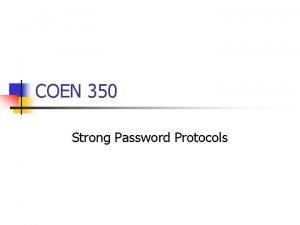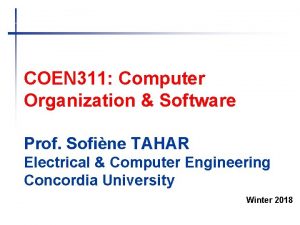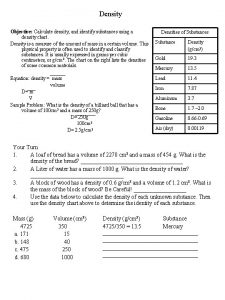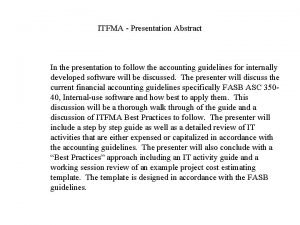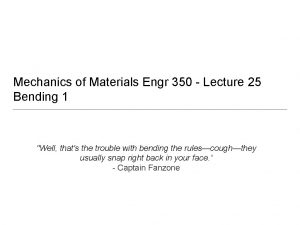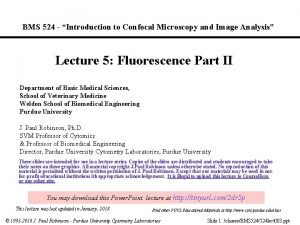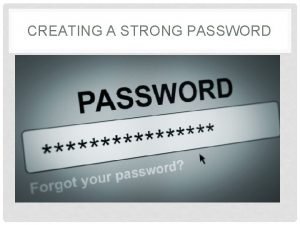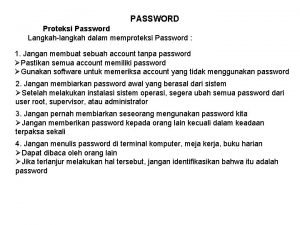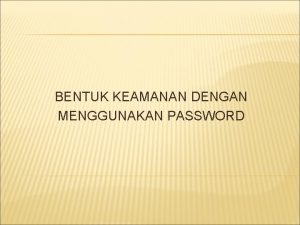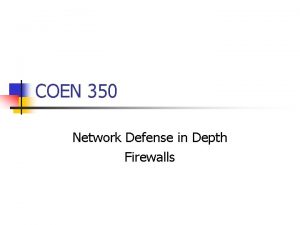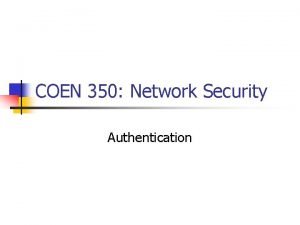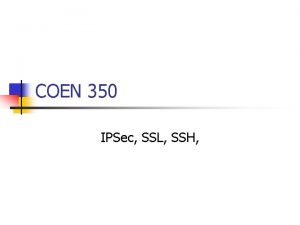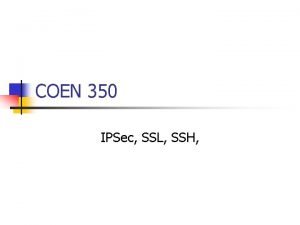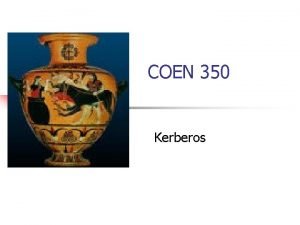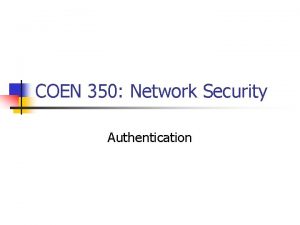COEN 350 Strong Password Protocols Strong Password Protocols

























- Slides: 25

COEN 350 Strong Password Protocols

Strong Password Protocols n Password authentication over a network n Transmit password in the clear. n n n Do Diffie-Hellman exchange to establish a secure key and an encrypted tunnel. n n Open to password sniffing. Open to impersonation of server. Establish a SSL connection. Use trust anchors for mutual authentication of machines. n Security depends on the security of the trust anchors.

Strong Password Protocols n Password authentication over a network n Compute a hash of the password. Use the hash as a secret key in a challenge response scheme. n Scheme: n n Alice to Bob: Login request Bob to Alice: Here is challenge R. Alice to Bob: f (hash(password), R) Open to dictionary attack by eavesdropper or someone impersonating Bob.

Strong Password Protocols n Password authentication over a network n Use a one-time password n n n Lamport Hash S/Key Use a strong password protocol n n Secure from dictionary attacks by impersonator or eavesdropper. Secure against impersonator on either side.

Lamport Hash n Bob stores n n Username Alice int n hn(password), h – one way function Password generation: n n n Alice chooses a password. Alice calculates hm(password) and sends it to Bob initializes the database entry.

Lamport Hash n Alice Protocol: Alice’s Workstation Alice n hn-1(pwd) Bob password Bob checks: Is h(Alice’s answer) = hn(password). If yes, authenticate. Then replace n with n-1 and store hn-1(password)

Lamport’s Hash with Salting n n To prevent password guessing, randomly generate a salt and store it at the server. Calculate hi(pwd, salt)

Lamport’s Hash n n n Alice’s workstation needs to regenerate the scheme with a new password whenever n counts down to 1. There is no mutual authentication. Vulnerable to the “small n” attack.

Lamport’s Hash n n n Mallory impersonates Bob. Alice tries to log on to Bob, but talks to Mallory sends a small n = n 0. Mallory calculates hn(pwd), n n 0. Mallory can now login.

S/Key n n Deployed version of Lamport hash. RFC 1938

Encrypted key exchange n n Alice has a “weak” password pswd. Bob stores a hash W = h(pswd) of the password. Alice’s workstation knows how to calculate W on the fly, once Alice types in her password. Use W in a way that does not give any hints on W.

Encrypted key exchange Alice Bob Alice and Bob share a weak secret W = h(password) Alice chooses a random Bob chooses a random b and number a. challenge C 1. Shea sends: Bob encrypts this message and finds. He that Alice has solved his challenge C 1. sends Both Bob and Alice use their knowledge ofa}W to encrypt their Alice, W { g Finally, authenticates himself proves his knowledge of W by Alice then. Bob proves her knowledge of to W Alice. by her. He ability ab. to calculate K. She b mutual messages. They both calculate K = g , C}1}able his picks knowledge of K, which proves to correctly encrypt Alice’s also a challenge C 2 andhesends KW {by C{1 gbeing , C to Bob. 2 challenge C 2. He sends K {C 2 } to Alice.

Encrypted key exchange EKE: Diffie-Hellman exchange with encryption. W hash of password. (Bob stores it, Alice can recalculate it). p Modulus. All calculation are based on it. Alice: "Alice", EW(ga) Bob: EW(gb), Challenge CBob At this point, both Alice and Bob calculate K = gab EK(CAlice, CBob) EK(CAlice)

EKE: Encrypted Key Exchange n n Secure against eavesdropper because all data are undistinguishable from random numbers. Eavesdropper cannot decide whether the ga, gb are the correct decryption. Secure against impersonation: n If treacherous Trudy impersonates Bob, she guesses a single value W in the first exchange. See the definition again.

Encrypted key exchange EKE: Diffie-Hellman exchange with encryption. W hash of password. (Bob stores it, Alice can recalculate it). Alice: "Alice", EW(ga) Bob: EW(gb), Challenge CBob At this point, both Alice and Bob calculate K = gab EK(CAlice, CBob) EK(CAlice)

SPEKE: Simple Password Exponential Key Exchange n Use W in place of g in the Diffie Hellman exchange. Alice: "Alice", Wa Bob: Wb, Challenge CBob At this point, both Alice and Bob calculate K = Wab EK(CAlice, CBob) EK(CAlice)

PDM: Password Derived Moduli n PDM uses modulus p that is a function of the password and uses 2 for g in Diffie Hellman. Alice: "Alice", EW(2 a mod p) Bob: EW(2 b mod p), Challenge CBob At this point, both Alice and Bob calculate K = 2 ab EK(CAlice, CBob) EK(CAlice)

Strong Passwords: EKE n A bad implementation of EKE allows an eavesdropper to exclude passwords. n Assume that we calculate in the field of number modulo p, p Nr of Exchanges Chance of false password surviving 1 2 n n 5 10 n 20 n 50 n a prime. Then ga and gb are both 80% m bit numbers smaller than p. 64% Attacker maintains a dictionary of possible passwords and observes many authentication 33% rounds. If W is in the dictionary, he encrypts Alice’s round 1 message M. If W -1{M } > p, then 10% attacker excludes W. 1. 2% Chance of excluding a false password W is 2 m – p / p. If this chance is about 80%, then 50 rounds determine the 0. 0014% password out of a normal dictionary.

Augmented Strong Password Protocols n n If someone knows W in EKE, they can impersonate Alice. Augmented Protocols n n n Trudy can steal Bob’s database Trudy can do a dictionary attack. If the dictionary attack is unsuccessful, then she cannot impersonate Alice. n Knowledge of W is not enough.

Augmented EKE n Bob stores “Alice, p, g. W mod p” Alice: "Alice", ga mod p Bob: gb + g. W mod p, u, Challenge CBob At this point, both Alice and Bob calculate K = gb(a+u. W) mod p Alice: EK(CBob), CAlice Bob: EK(CAlice)

Strong Passwords n Augmented PDM n Server Information Creation n Alice has password pssw Alice sends to Bob n p = f (pssw) [this is a prime] n W = hash (pssw) [one-way hash] Bob stores: n Alice, p, W,

Strong Passwords: Augmented PDM Bob Alice chooses creates a random number ba. . a mod p Alice 2 W Bob She calculates recomputes 2 b mod and p. from her password. Alice knows that Bob is Bob because Bob proves that b, hash (2 ab mod p , 2 b. W mod p) to Bob sends 2 b. W he knows 2. Alice 1 now sends Alice hash 2 (2 ab mod p , 2 b. W mod p) Bob knows that Alice is Alice because she proves to him that she knows W. If Alice had just broken into the server, she would have to calculate 2 b. W from 2 W mod p.

Augmented PDM n n Bob stores Alice, p, 2 w mod p and picks b Alice computes p and W=hash(passwd) from the password and picks a. Alice: "Alice", (2 a mod p) Bob: (2 b), Hash 1(2 ab mod p, 2 b. W mod p) Alice: Hash 2(2 ab mod p, 2 b. W mod p)

Strong Passwords n Secure Remote Password n n RFC 2945 Bob stores {Alice, g. W mod p}, where W = f (passwd).

Strong Passwords SRP Alice creates random a and sends ga to Bob creates random b, challenge CBOB and 32 b number u. Bob sends gb + g. W mod p, u, CBOB to Alice. Both calculate K = g b(a+u. W) mod p. Alice sends K {CBob}, CAlice to Bob sends K {CAlice} to Bob.
 Ephesians 6:10-20 nkjv
Ephesians 6:10-20 nkjv Coen 311 concordia
Coen 311 concordia Coen 445
Coen 445 Coen 445
Coen 445 Strong password protocol
Strong password protocol Coen 352
Coen 352 Coen 311
Coen 311 Coen 6501
Coen 6501 Characteristics of a strong password
Characteristics of a strong password Qwerty123 is a strong password
Qwerty123 is a strong password Acid base titration curve
Acid base titration curve Strong base weak base
Strong base weak base Strong acid list
Strong acid list Mgkp
Mgkp Net ionic equation
Net ionic equation How to remember strong acids and strong bases
How to remember strong acids and strong bases 4725/350
4725/350 350-170-120
350-170-120 Itfma 2019
Itfma 2019 Kussmaul's sign
Kussmaul's sign Stat 350
Stat 350 Rounding numbers to the nearest hundred
Rounding numbers to the nearest hundred Compsci 345
Compsci 345 Engr 350
Engr 350 Fincoid 350
Fincoid 350 (780) 632-350
(780) 632-350




